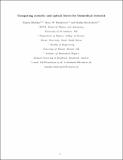Comparing acoustic and optical forces for biomedical research
Abstract
The application of acoustic and optical waves to exert non-contact forces on microscopic and mesoscopic objects has grown considerably in importance in the past few decades. Different physical principles govern the acoustic and optical forces, leading to diverse biomedical applications. Biocompatibility is crucial, and useful optical and acoustic forces can be applied in devices that maintain local heating to acceptable levels. Current acoustic and optical devices work on complementary length scales, with both modalities having useful capabilities at the scale of the cell. Optical devices also cover subcellular scales and acoustic devices also cover supercellular scales. This complementarity has led to the emergence of multimode manipulation, often with integrated imaging. In this Technical Review, we provide an overview of optical and acoustic forces, before comparing and contrasting the use of these modalities, or combinations thereof, in terms of sample manipulation and suitability for biomedical studies. We conclude with our perspective on the applications in which we expect to see notable developments in the near future.
Citation
Dholakia , K , Drinkwater , B W & Ritsch-Marte , M 2020 , ' Comparing acoustic and optical forces for biomedical research ' , Nature Reviews Physics , vol. 2 , no. 9 , pp. 480–491 . https://doi.org/10.1038/s42254-020-0215-3
Publication
Nature Reviews Physics
Status
Peer reviewed
ISSN
2522-5820Type
Journal article
Description
K.D. thanks the UK Engineering and Physical Sciences Research Council for funding (grant number EP/P030017/1). B.W.D. gratefully acknowledges funding from the Wolfson Foundation and the Royal Society. M.R.-M. gratefully acknowledges support from the Austrian Science Fund FWF (SFB-project F6806-N36).Collections
Items in the St Andrews Research Repository are protected by copyright, with all rights reserved, unless otherwise indicated.

